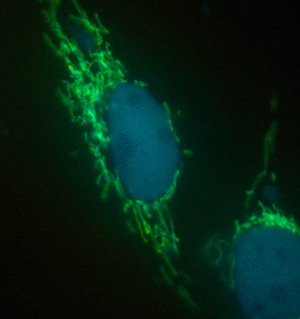Sep. 8, 2006 Research Highlight Biology
Variability in mitochondrial DNA linked to longevity
Direct mechanism found connecting complex diseases with changes in mitochondrial DNA
 Figure 1: A pseudocolor color image of a cybrid with fluorescent indicators targeted to mitochondria (green) and nucleus (blue). PLoS Genetics/ Public Library of Science/ 2(8)/ 0003
Figure 1: A pseudocolor color image of a cybrid with fluorescent indicators targeted to mitochondria (green) and nucleus (blue). PLoS Genetics/ Public Library of Science/ 2(8)/ 0003
A Japanese team led by RIKEN researchers has accumulated evidence of how genetic variability in the mitochondria—the energy production centres of the cell—can affect longevity.
The mitochondria, which are distributed in the body of the cell outside the nucleus, have their own DNA. It codes for parts of the enzymes involved in energy production as well as their protein manufacture system.
Mitochondrial DNA tends to have a relatively high degree of variability. Some of the mutations, or polymorphisms, are associated directly with muscle and nervous disorders; others appear to increase the risk of complex diseases, such as diabetes, Alzheimer’s disease, Parkinson’s disease, bipolar disorder and cancer. It is also reported that mitochondrial polymorphisms are related to individual variability in cognition, personality, athletic performance and longevity. Until now, however, there has been no direct biochemical and physiological mechanism to link these outcomes with changes in DNA.
In work reported online in PLoS Genetics 1, the research team used specially constructed cell lines to discover that two closely linked polymorphisms that code for respiratory chain proteins can affect the acidity and the levels of calcium inside the mitochondria. The finding opens the possibility of preventing any associated medical conditions with drugs that reverse these changes.
“We are now interested in the impact of this genetic variability on nerve and brain function,” says research project leader, Tadafumi Kato of RIKEN’s Brain Science Institute in Wako. “But it will be very challenging.”
In the course of its work, the research team created a series of cybrid cell lines. A cybrid is a hybrid cell formed by fusing cells treated to remove their mitochondrial DNA with cell fragments containing mitochondria, in this case platelets from the blood of 35 volunteers. The researchers incorporated fluorescent tags for calcium measurement into their cybrid cells (Fig. 1) and, using the fluorescence, were able to measure calcium levels within mitochondria.
By sequencing the mitochondrial DNA of these cell lines, the researchers identified two polymorphisms associated with changed calcium levels. These polymorphisms also affected the pH in mitochondria. These factors, calcium levels and pH, are linked to fundamental activities of the mitochondria.
One of the polymorphisms the researchers identified is known to be a risk factor for the disease conditions mentioned above. Previous studies have shown that individuals aged 100 years old or more tend not to possess this polymorphism.
References
- 1. Kazuno, A., Munakata, K., Nagai, T., Shimozono, S., Tanaka, M., Yoneda, M., Kato, N., Miyawaki, A. & Kato, T. Identification of mitochondrial DNA polymorphisms that alter mitochondrial matrix pH and intracellular calcium dynamics. PLoS Genetics 2, Issue 8: e128 (2006). doi: 10.1371/journal.pgen.0020128
